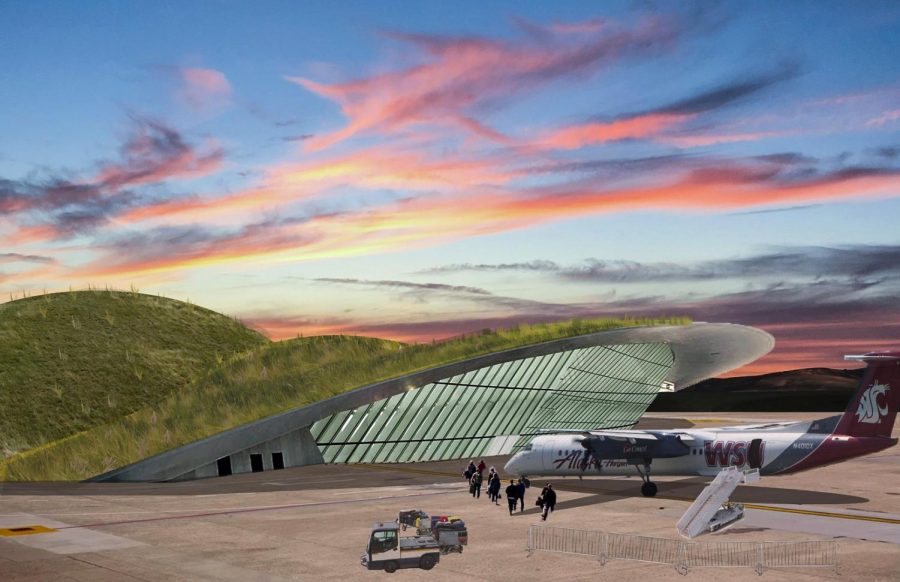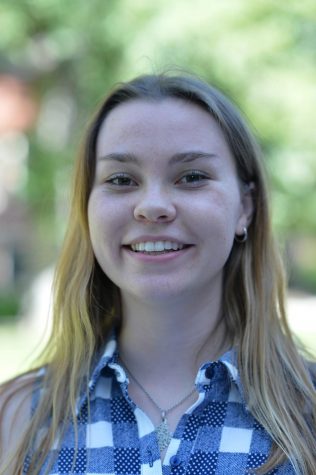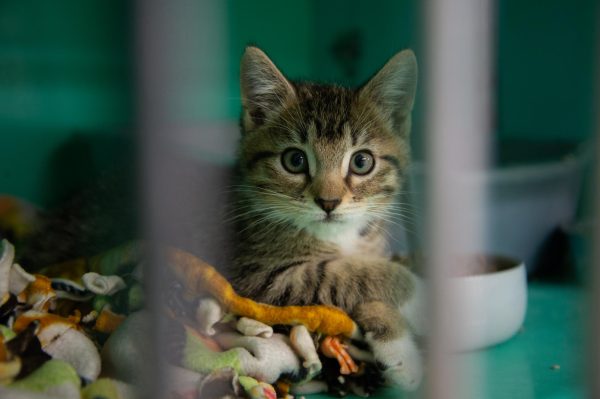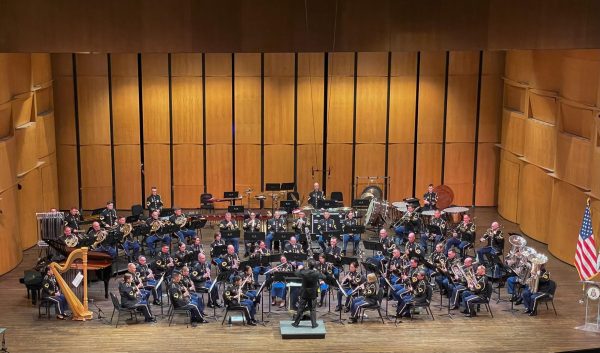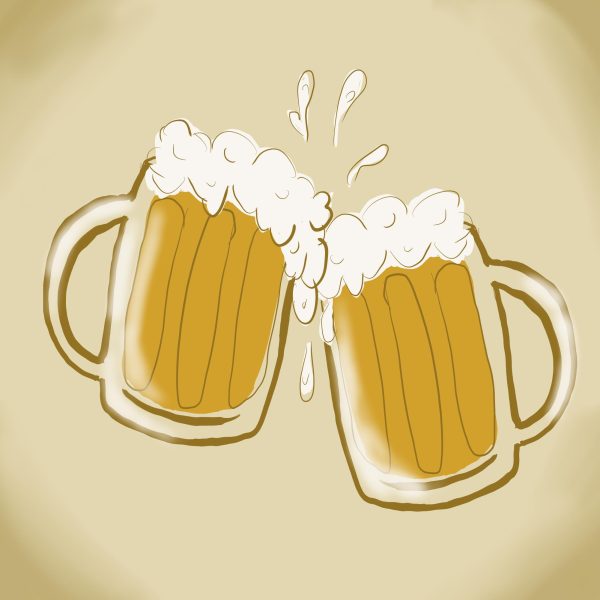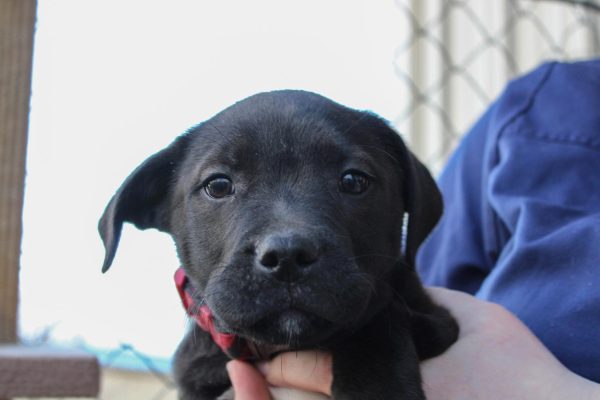Architecture students reimagine Pullman
Gondola system, eco-friendly terminal plan inspired by Palouse hills could launch city in new direction
A new terminal design features a living roof system with native plants, as illustrated by Jesse Conner, a junior studying landscape architecture.
March 18, 2019
A WSU professor of landscape architecture wants to start conversations to radically change the city of Pullman.

Jaime Kemple, junior landscape architecure major, illustrated this gondola image and laid out the students’ magazine.
This semester, Steve Austin’s class of 14 landscape architecture juniors worked in pairs to design plans for their booklet, “Seven Ideas to Transform Our City.” In the fall, seniors in the field worked on “Pullman Vital Signs,” a research project focused on improving downtown Pullman.
“It’s the same idea,” Austin said. “How can we at WSU make things better in Pullman?”
The seven ideas included a gondola that could run from the Terrell Library to a point near downtown’s Pullman Heritage Depot, formerly known as Pufferbelly Station.
Jaime Kemple, a landscape architect student in the class, worked on illustrations of the gondola and designed the Seven Ideas magazine. She said the gondola would connect the university and downtown.
“I walk up that hill every single day,” she said. “I like the idea of a peaceful ride up the hill, the views, looking at the Palouse hills in the distance and seeing Kamiak Butte.”
Austin said a beautiful ride could put Pullman on the map, but it could also address the city’s practical issues.
Pullman Vital Signs research from seniors last semester found that the disconnection between campus and downtown has created a “dead zone.” Kemple said new public transportation could increase business downtown and visitation on campus.
“It’s really difficult to come up on campus and visit for any reason whatsoever,” Kemple said. “Parking is a nightmare.”
As WSU builds new projects on existing lots, parking spaces are dwindling, Kemple said. The gondola could allow visitors to park downtown and still reach campus easily, bringing money into WSU.
But the juniors’ project wasn’t focused on cost-effectiveness. The goal of the project was to inspire.
“I said dream big and assume if it’s a good idea, people can find the money,” Austin said.

The gondola would run over Thompson Flatts and deposit travelers near Terrell Library, as depicted in this rendering by junior landscape architecture major Brittany Steinbeck.
The ideas Austin assigned came to him through growing buzz in the community. He said creating visuals is just the beginning.
For Kemple, these stirring images have special meaning. Kemple was born on campus in the former hospital — now the Cougar Health Services building — and lived in Pullman until age 10. She returned to retrain in landscape architecture as a nontraditional student.
She felt especially moved by the new Moscow-Pullman Regional Airport terminal design, which drew on the natural beauty of the Palouse. The design mirrored rolling hills.
According to the Seven Ideas class magazine, Tony Bean, the airport’s executive director, said a new terminal is in order. Students designed a rounded terminal with a living roof system made up of native grasses and shrubs. An underground parking structure would use the same green roof.
“The green roofs on top are from a really eco-forward perspective,” Kemple said. “I’d like to see that perspective ingrained in every project we do here.”
The seven ideas for Pullman also include a two-acre raised park over the north downtown parking lot. This park would overlook Main Street and the South Fork of the Palouse River. It would feature a dedicated area for the farmer market and the design would leave 60 of the 80 parking spots available.
Another park could replace a portion of Walmart’s massive parking lot. A multicolored glowing glass art bridge could replace the old bridge and train tracks beside Neil Public Library. Sustainable landscapes made up of drought tolerant native perennials for new suburban houses would address local resource issues.
“[The project] was more about creating conversation than getting into the details of design work,” Kemple said. “I think that’s a piece of our discipline that we sometimes are too busy to think about, but it’s really important.”
Though the juniors’ goals were more creative than practical, seniors working on Pullman Vital Signs faced the city’s logistical issues head-on.
Seniors unrolled their eight-foot-long poster to present their findings to the Downtown Pullman Association last semester. According to their research, the business problems downtown don’t stem from limited parking space. Pullman has plenty of available parking spots at any given time. The issues come from the composition of businesses.
According to the research, only 32 percent of businesses downtown are open after 6 p.m. and only 47 percent are open on weekends. Their research suggests the majority of businesses should be open late into the evening.
Downtown could also be uninviting because only 25 percent of street frontage and facades are active storefronts, while 75% are made up of vacancies, blank walls and parking lots, according to the poster. They counted 16 vacancies this fall.
Shadows cast from the new Evolve building cover much of the street, and another six-storey building nearby could also darken the entire main strip. Also according to their work, wide lanes encourage drivers to speed, which discourages pedestrians from spending time downtown.
Seniors suggested the city should protect trees downtown. Research indicates that higher density of trees lower stress levels in city inhabitants and that canopy coverage can lower temperatures in the summer, according to their poster.
“One of downtown’s most endearing qualities is its visual connection to the WSU campus,” the poster read.
Visually, downtown has the beginnings of a public art scene, according to the research. Students advised we support public art and protect views of the university.
Austin said the city was very receptive to the students’ findings.
“A lot of these things people kind of knew but now they’ve got the research to add to it,” Austin said.
Austin said information from Vital Signs will be useful for the professional consultant the city has hired to create a master plan for Pullman.
Still, big ideas from the Seven Ideas project could solve problems brought up in Pullman Vital Signs.
“You never know, if we’re talking about it and it’s in the paper, somebody in Seattle will see it and they’ll say ‘that’s a great idea, we ought to make it happen,’ ” Austin said.


